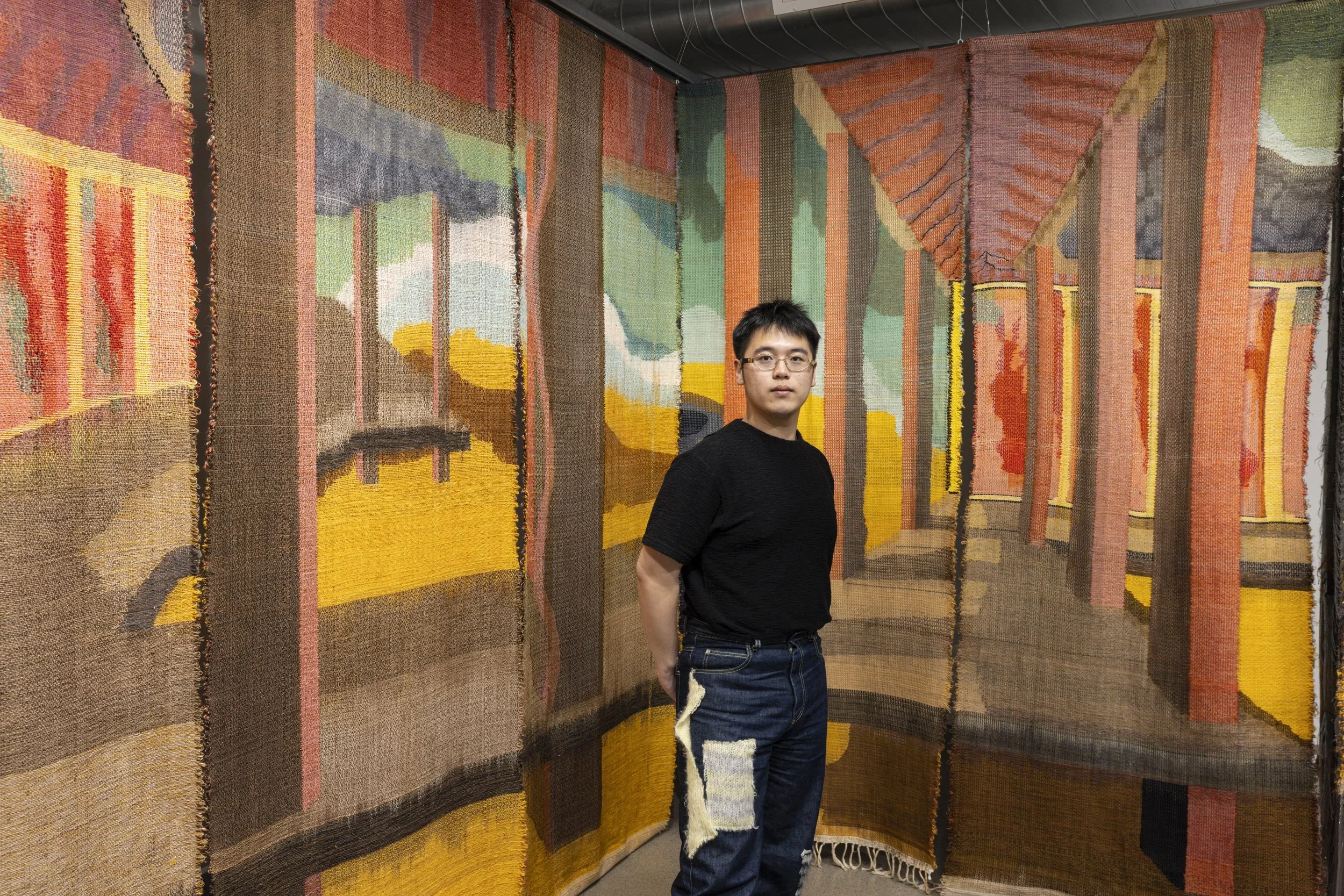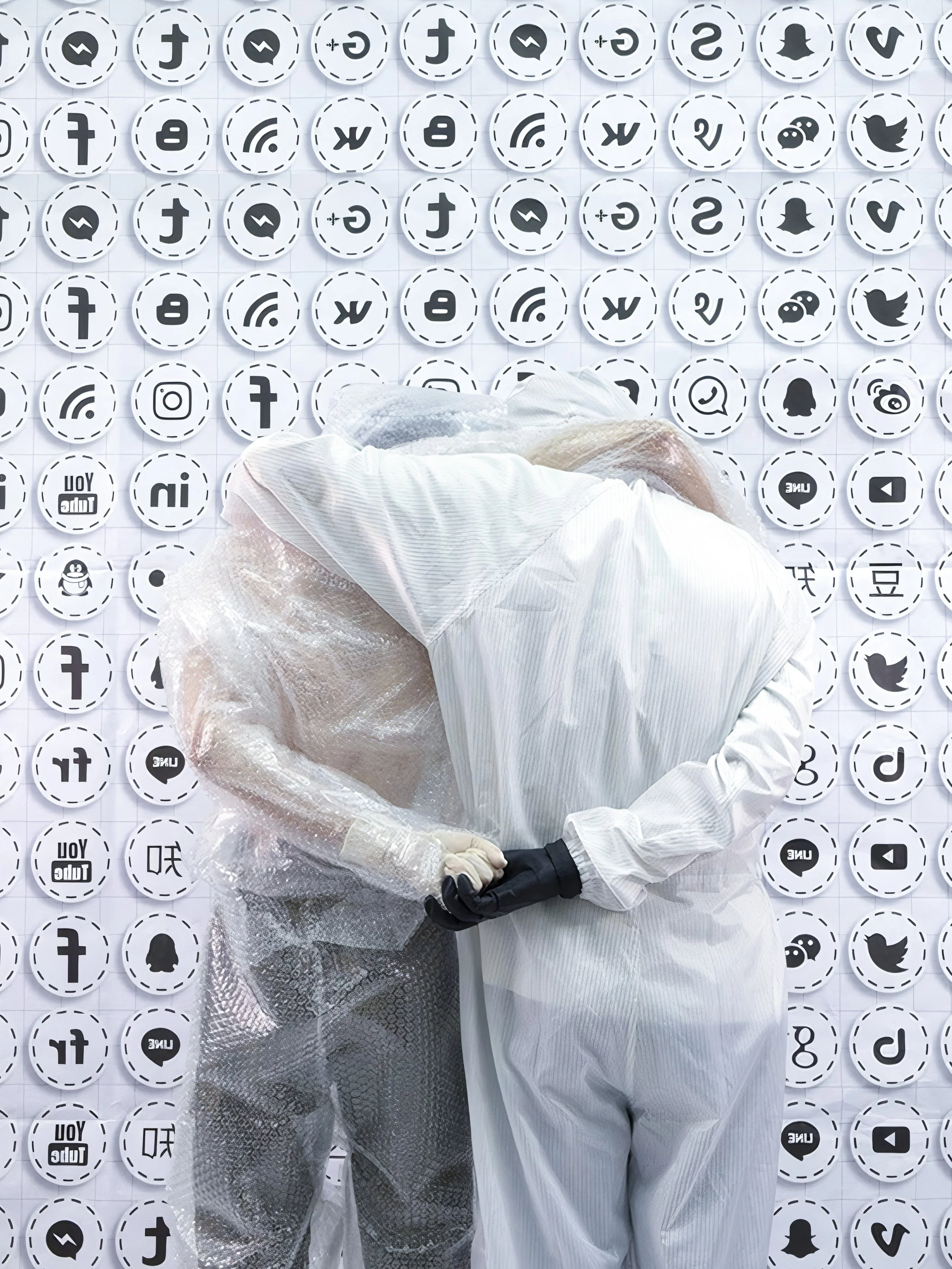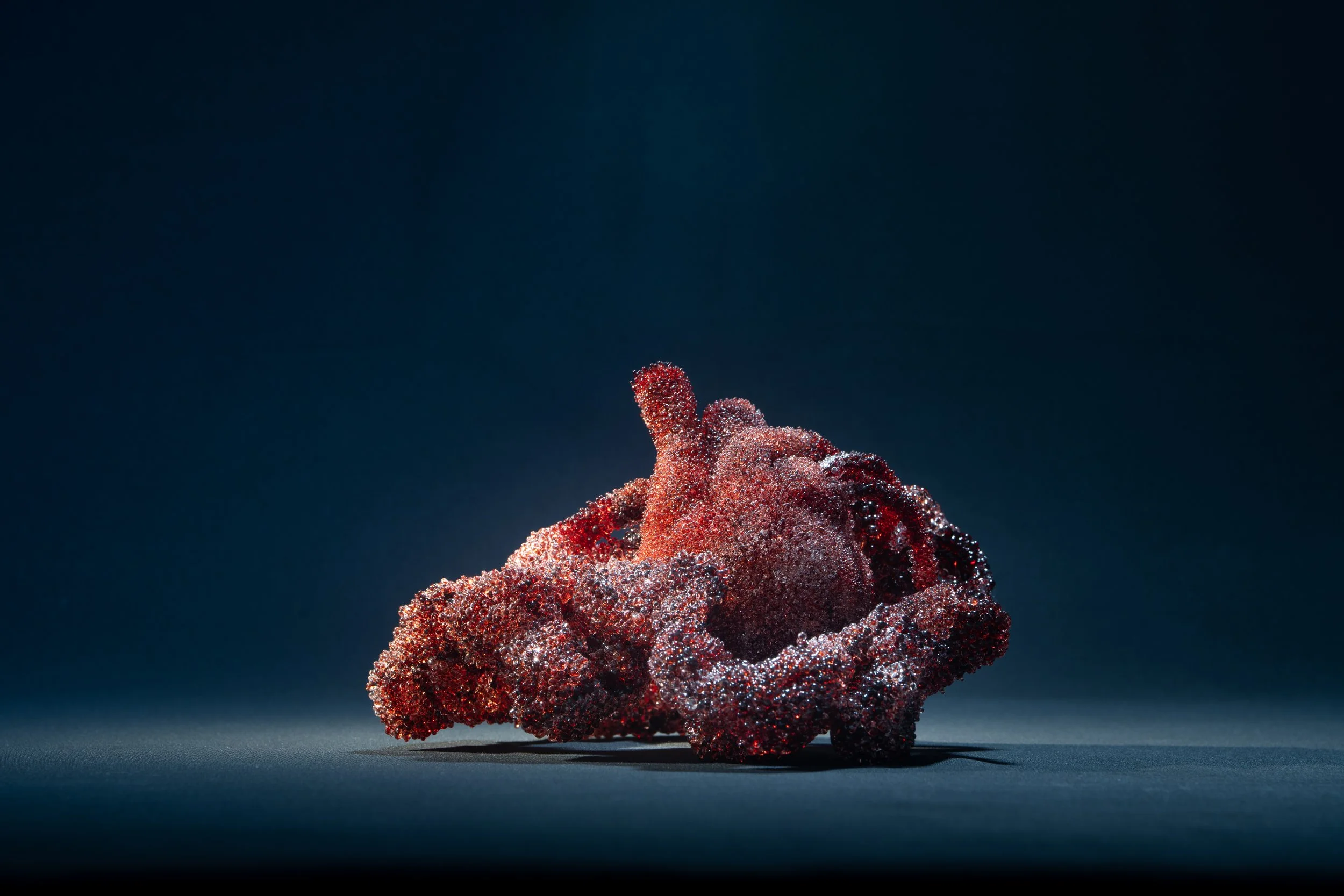10 Questions with Siyu Liu
Al-Tiba9 Art Magazine ISSUE15 | Featured Artist
Siyu Liu, originally from China, is an architect and artist based in Spain. After studying and working in the architecture area for six years in Barcelona, she has become a half-Mediterranean. She turned her direction into craft with intercultural and identity research during the pandemic. During her inaugural year as an artist, her unique research has led her exhibit in Spain, Italy, Germany, Korea, and China, including prominent events like Milan Design Week 2023 and 2024. Her works have been shortlisted for the RA Summer Exhibition 2024, nominated for the Talente - Meister der Zukunft 2024 international craft and design competition, and collected by the director of the Mies van der Rohe Foundation.
Siyu Liu - Portrait
ARTIST STATEMENT
Siyu Liu was born in Guizhou province, an aboriginal and hilly region in southwestern China, to the east of the Himalayas. Her hometown provided her with a vibrant, natural, and untamed backdrop, contrasting traditional Chinese Confucian education. After pursuing her studies and working in architecture in Barcelona for six years, she has embraced a dual Mediterranean and Chinese identity. Siyu's artistic journey is driven by the desire to preserve and integrate the unique memories and identities of these two regions, especially in an age marked by material excess. Through her craftworks, she focuses on intercultural research, uncovering and elucidating subtle differences in various cultures that arise from the same physical elements. Siyu approaches her creative process with a playful attitude, finding joy in her work. Her material and technique preferences are deeply rooted in her background in architecture.
Traveling Vases - I, Raffia, cotton yarn, 30 x 24 x 35 cm, 2024 © Siyu Liu
Florist: Xuehan Lu
Photographer: Xuehan Lu, Xuan Tang
AL-TIBA9 ART MAGAZINE ORIGINAL ISSUE15
INTERVIEW
Let's start from your childhood. Growing up in Guizhou province, you experienced contrasting landscapes and cultural influences. How do these diverse experiences inform your artistic practice and identity as an artist?
My hometown, Guizhou Province, is a hilly area, resembling a staircase from the Himalayas to the coastal regions of Guangzhou Province. The continuous mountain ranges made transportation inconvenient, resulting in a diverse and independent aboriginal culture. You can think of my hometown as similar to the Basque Country, where the people have developed their unique culture and language due to the isolation imposed by mountains. Similarly, I belong first to my hometown and then to Chinese culture. In fact, my hometown shares many similarities with Spain - potatoes are a popular staple, people enjoy drinking and festivities, and colorful clothing is part of our tradition. This is perhaps why I feel a strong sense of belonging there. Consequently, understanding mainstream Chinese culture was very difficult for me as a child. Due to the inconvenience of transportation, for a long time, I, like many foreigners, only saw pictures of the Forbidden City, the Great Wall, and Chinese private gardens near Shanghai. Although my knowledge of literature and history gave me a sense of belonging, I still felt like an outsider for a long time. Or rather, I found myself describing mainstream Chinese culture from a detached, third-person perspective. These experiences made me realize the diversity of identity and the importance of tangible physical reference points in cross-cultural understanding.
You later approached architecture, studying in Barcelona. Why did you choose this city? And how did it influence your work?
To be honest, it was Barcelona that chose me. After studying Castilian for a year in Salamanca, both Madrid and Navarra universities rejected me, while UPC gave me an offer. Upon graduating from the master's program, my working experience as an architect at EMBA Estudi shaped me. It is a great local architectural company with a strong emphasis on attention to detail. During my time there, I was primarily responsible for collage and handmade models. My boss and colleagues always wanted me to hide all the interfaces, although this was sometimes very challenging. Overall, it's a story of a meticulous person joining an equally meticulous company, and everything went very smoothly. These habits continue to shape my approach to work to this day.
Mediterranean Series - cactus, fountain, coral, paper raffia, 13x15x20 cm, 17x15x23 cm, 10x15x13 cm, 2023 © Siyu Liu
The Mediterranean Series captures the essence of life in the Mediterranean over the past two years. The impact of consecutive droughts and conflicts in the surrounding regions is evident in withered cacti, inactive public fountains, and climate-affected red coral. Employing traditional Mediterranean basket weaving techniques, the series intricately weaves soft raffia paper to create a texture reminiscent of porcelain.
Speaking of your work, can you share some insights into your material and technique preferences and how they are influenced by your background in architecture?
When I was studying architecture, I liked construction more than theory. I prefer low-tech compared to high-tech because high-tech often means high control. It is a pity that I can't find the creator's personal choices and preferences based on many outcomes derived from cutting-edge computer-aided technologies. In my creative process, I enjoy exploring how to push materials to their limits using limited technology while still fulfilling the concept. This process is like catching a raindrop with a bottle cap precisely. Therefore, whenever I acquire just the basics of a technique, I start to think about the possibility of a combination of concept, form, material, etc. Regarding the traditional Spanish basket weaving technique I primarily use, I've only attended three workshops so far. However, my idea list is already quite long.
Talking about materials, I love textures and wrinkles. As the "In Praise of Shadows" described, Eastern preference for the indirect. Absolute materials like highly polished stainless steel and sharp right angles challenge my comprehension. Smoothness obstructs my understanding; it's as if my understanding is merely superficial, like a towel used to polish them. Conversely, if a rough surface is filled with folds, providing infinite diffuse reflections, or if the material's density is uneven, my enthusiasm is ignited. Understanding its changes under pressure, tension, and torsion inspires me. The uncertainty, similar to gambling, excites me like an adventure. I am exploring a precise ambiguity.
You mentioned that your craftworks focus on intercultural research, as you have now embraced a dual Mediterranean and Chinese identity. Could you elaborate on how you reflect on cultural differences and introduce them into your art?
For me, crafting serves as a perspective for understanding identities. It shows the various connections between people, land, natural materials, linkages between the production of goods, and cultural practices. Having constantly studied the countryside of Catalonia and meeting live craftsmen, I learned utterances that are not expressible in vocal languages - that is, life itself and the priorities that constitute local life. Focusing on containers, I delved into the world where people relied on local natural materials to carry life's necessities before the Industrial Revolution. Farms, olive groves, vineyards, and fishing were central to Mediterranean life. It took me almost two years in a series of basket workshops and field surveys to learn this. I also realized that bamboo, a typical material for baskets in Asia, Central Africa, and South America, does not grow in Europe.
Then, I will choose a common theme after recognizing differences in materials and craftsmanship. For example, I noticed fishmongers stack fish together in circles to form towers in Mediterranean fish markets, while Chinese fish markets look like aquariums because the Chinese prefer live fish. This inspired me to create a vase with rotating openings to record the identity of Mediterranean fish markets. I also found a subtle difference in the use of cultural symbols of poultry in Western and Eastern cultures. Chicken-shaped containers are widely used in the Western world because of the cultural background related to Easter. However, duck-shaped containers are more popular in China because duck symbolizes love in the Chinese context, as ducks usually appear in pairs. So, I made a duck-shaped vase. These two pieces made up my first creation after graduation. They are also inspired by Chinese porcelain and are weaved using the Spanish braid basket weaving technique. Some viewers even mistook my paper creations for ceramics when they passed by quickly.
Traveling Vases - II, raffia, cotton yarn, special yarn, 16x18x20 cm, 2023 © Siyu Liu
Traveling Vases - IV, raffia, cotton yarn, 17x15x20 cm, 2023 © Siyu Liu
Traveling Vases - III, raffia, cotton yarn, 16x18x20 cm, 2023 © Siyu Liu
Traveling Vases - V, raffia, cotton yarn, 21x17x12 cm, 2023 © Siyu Liu
Your statement also mentions a playful attitude towards your creative process. How does this playfulness manifest in your artwork?
Initially, creating was just a hobby for me. I used it as a means to express feelings and experiences that couldn't be captured through language. At that time, I only shared my creations with close friends and didn't have any further ambitions. As an East Asian, I felt the pressure to make my family proud, much like Mulan. Additionally, as a Chinese, I was aware that I might end up in a humble position at a large company, contributing to the global market. It was for these reasons that I chose to become an architect—a respectable and useful profession. However, the pandemic disrupted my plans, and the worsening economic conditions compelled me to return to UPC for another master's program to renew my visa. These interesting creations were submitted as assignments, and that's when I was discovered, gradually paving my way into the world of art. Playfulness became my rebellion against the situation of becoming a useful, repetitive, and low-paid Chinese or Asian employee. Therefore, I created a series of fun, useless, unique, and joyful artworks.
Ultimately, what inspires you to create? Are there any specific themes or concepts that consistently recur in your artwork?
The characteristics and pride associated with a land continuously inspire my creations. Personally, I find myself drawn to themes of water, light, and time.
In my hometown, the high mountains transform vapor into rain and springs, serving as water sources. However, they also bring about persistent poverty. Most of the water flows into underground caves, making it unsuitable for irrigating farmland. This is why potatoes are our traditional staple food. Moreover, the rugged terrain hinders road construction and industrial development, sparing the area from pollution and profit. Abundant spring rainfall often leads to natural disasters like floods and landslides, reshaping the landscape suddenly. This relationship with mountains and rain is similar to that of San Sebastian. During my residency there, they understood my passion for mountains and water, which are integral to both of our identities. Living in Barcelona, I like fountains and seawater, although public fountains are now inactive due to economic reasons.
I particularly appreciate indirect light, such as moonlight. In Chinese culture, the full moon symbolizes family reunions. One evening in 2022, as I strolled along Diagonal Avenue, the sight of the full moon evoked a surge of emotions, as I had been separated from my family for three years due to the pandemic. Later, I told my thesis tutor I wanted to abandon everything in Spain because my efforts seemed like nonsense in front of immense difficulties. The struggle is similar to the two Chinese idioms "fishing for the moon in the water" and "drawing water with a bamboo basket," which signify something nearly impossible to obtain. She mentioned a similar Catalan saying, "La luna en un cove." Coincidentally, during my search for fiber materials, Miquel, the owner of the yarn shop "All You Knit is Love" in Barcelona, assisted me. He introduced me to Sant Feliu de Pallerols in Catalonia, where I saw the "Pesca Llunes" sculpture. I was touched by how two cultures arrived at a similar concept independently.
The different perception of time also captivates me. Before the Industrial Revolution, precise timekeeping was not as crucial. In Catalan, time is marked by the ringing of bells, while the Chinese perceive time on a yearly basis. During various festivals throughout the year, specific paper items like lanterns, flowers, and money are burned or replaced. It is a signal to me that things will renew, fade, or disappear with each passing year. That's why I incorporate raffia paper into my work, challenging the concept of permanence.
Mushroom Series 01, Paper raffia, 10x15x15 cm, 2022 © Siyu Liu
Mushroom Series 03, Paper raffia, 16x20x22 cm, 2023 © Siyu Liu
As an artist who has navigated multiple cultural landscapes, what message or impact do you hope your art will have on viewers, both locally and globally?
Identity and regional pride are closely intertwined. I aim for my artwork to serve as a reflection of diverse cultures, allowing viewers to recognize elements of their own heritage while gaining insight into how other cultures interpret similar themes. Unfortunately, fragmented understandings and the proliferation of cheap industrial products erode our systematic understanding of local traditions. Choosing handicrafts as my medium, I want to preserve and develop this tradition.
In terms of international exchange, when a group's ego is too dominant, it often prevents them from understanding other groups. People tend to focus only on their own identity, and they are unable to hear the voices of distant cultures directly, even with the internet. This leads to misunderstandings and discrimination worldwide. Meanwhile, understanding abstract concepts from distant, unfamiliar cultures is also challenging. Just as in my upbringing, I am familiar with local aboriginal cultures rather than dominant cultures near Shanghai or Beijing. I hope to develop a tangible reference system as a foundation for cross-cultural understanding, similar to how I rely on learning Spanish to study Italian. Overall, I hope my work can preserve tradition, alleviate international misunderstandings, and promote cross-cultural communication.
Speaking of viewers, your works have been exhibited in various countries, including Spain, Italy, Germany, Korea, and China. Can you discuss how your art resonates with audiences from different cultural backgrounds?
I take pride in the fact that viewers from different backgrounds can always find entrances that resonate with their own cultural experiences. For instance, Japanese viewers quickly recognize the influence of Chinese ceramics in my vases. Chinese observers often assume I am using bamboo weaving techniques, while Spanish and Portuguese immediately identify it as the traditional Iberian basket weaving techniques. Meanwhile, Germans fully understand my enthusiasm for mushrooms.
It is also fascinating to see that people from different cultural backgrounds have different reference points. During my first participation at Corso Como 10 for Milan Design Week last year, I initially displayed my pieces vertically, as my reference point was Chinese porcelain. However, my Italian curator believed the artwork should be more organic and would adjust the pieces to bend after my adjustments. Consequently, in the final photos I received, none of the vases were displayed vertically.
Vase-China | Into the Blue, special edition for Milan Design Week, paper raffia, 8x10x18 cm, 2022 © Siyu Liu
Your participation in events like Milan Design Week, or being nominated for the Talente - Meister der Zukunft 2024 and the 2024 RA Summer Exhibition are significant achievements. How do these experiences shape your artistic goals and aspirations?
For me, these experiences have confirmed that the path I'm currently on is the right one. Just as my friends, classmates, professors, and former bosses advised, I am better suited for applied arts than architecture. In fact, in my first year of operating as an artist, which was last year, I was quite nervous because I lacked any formal education in art and had no connections in the field. As an architect, my strengths lie in managing multiple projects simultaneously within limited time frames. I diligently applied to numerous open calls and, ultimately, achieved promising results. These affirmations have convinced me that there are others like me in the world, curious and eager about the future of diversity and multiplicity.
And lastly, re there any future projects or directions in your artistic practice that you're particu arly excited about exploring?
There are three directions I'm eager to explore this year. Firstly, I want to delve deeper into digitizing traditional handicrafts by incorporating conductive yarn to transform weaving results into touch sensors. This project is almost ready for release, and I am just waiting on some final photographs. Secondly, I aim to push the boundaries of the traditional Spanish braiding basket weaving technique in terms of form, materials, colors, and concepts. Additionally, I hope to further understand locally representative seasonal plants. In my hometown, specific flowers blooming would signal the end of winter or the arrival of spring. I have yet to identify similar plants locally that serve as a biological clock.




























